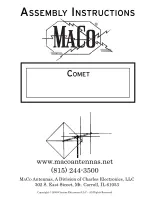
- 10 -
For single antenna installations, the
DXE-FVI-1
Feedline Voltage Injector is usually installed near
the operating position. When using the Active Receive Antenna, the
DXE-FVI-1
powers the
ARAH
active matching amplifier through its
ANT
feedline connection. See
Figure 7
.
Important Note: DO NOT connect the ANT terminals to the feed line shield or attach the
feed line shield to the amplifier case.
The feedline connectors must remain dry. Do not place any intentional DC shorts or opens on
the feedline between the FVI-1 and the ARAH. This includes lightning arrestors, splitters, or
any other accessory not intended for feedlines that carry power or control voltages.
The included 120 VAC 60 Hz, +12 Vdc wall mounted transformer power
supply connects to the +12 Vdc input. The center of the 2.1mm power plug is
positive. Larger power supplies or station power may also be used provided
there is an in-line 1 ampere fast-blow fuse. The RCA phono-style plug
connects to the receiver antenna input.
See Appendix A for Radio Interface Options
Coaxial Cable Feedline
Flooded 75 Ω CATV type feedline cable (F-6) is strongly recommended for use with the ARAH
systems.
DXE-F6
Flooded 75 Ω CATV type feedline cable has a bonded foil to improve shielding.
Moisture typically seeps in around the shield and can cause increased noise. Flooded style cables
have the distinct advantage of automatically sealing small accidental cuts or lacerations of the
jacket. Flooded cable also prevents shield contamination and has a gummy liquid inside that seals
cuts or nicks, displaces water, and can be direct buried.
The feedline is used to provide power for the ARAH matching unit. We
recommend the use
of
DXE-SNS6-25
Snap-N-Seal type F connectors to
ensure high quality and weather resistant feedline connections. Use the
proper tool to crimp these connectors.
To help decouple the feedline from radiated noise, bury the feedline for some distance from the
antenna when the feedline reaches the ground. A
DXE-RFCC-1
DX Engineering Receive Feedline
Choke will also ensure feedline decoupling.






































